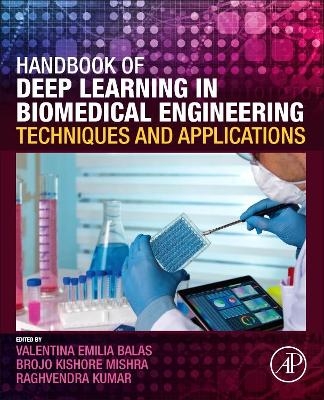
Handbook of Deep Learning in Biomedical Engineering
Academic Press Inc (Verlag)
978-0-12-823014-5 (ISBN)
Valentina Emilia Balas is currently a Full Professor in the Department of Automatics and Applied Software at the Faculty of Engineering, “Aurel Vlaicu University of Arad, Romania. She holds a PhD cum Laude in Applied Electronics and Telecommunications from the Polytechnic University of Timisoara. Dr. Balas is the author of more than 350 research papers. She is the Editor-in-Chief of the 'International Journal of Advanced Intelligence Paradigms' and the 'International Journal of Computational Systems Engineering', an editorial board member for several other national and international publications, and an expert evaluator for national and international projects and PhD theses. Dr. Brojo Kishore Mishra is currently working as a Professor in the Department of Computer Science and Engineering at the GIET University, Gunupur-765022, India. He received his PhD degree in Computer Science from the Berhampur University in 2012. He has published more than 30 research papers in national and international conference proceedings, 25 research papers in peer-reviewed journals, and 22 book chapters; authored 2 books; and edited 4 books. His research interests include data mining, machine learning, soft computing, and security. He has organized and co organized local and international conferences and also edited several special issues for journals. He is the Senior Member of IEEE and Life Member of CSI, ISTE. He is the Editor of CSI Journal of Computing. Raghvendra Kumar is working as an Associate Professor in Computer Science and Engineering Department at GIET University, India. He received BTech, MTech, and PhD in Computer Science and Engineering, India, and Postdoc Fellow from the Institute of Information Technology, Virtual Reality and Multimedia, Vietnam. He has published a number of research papers in international journals and conferences. His research areas are computer networks, data mining, cloud computing, and secure multiparty computations, theory of computer science, and design of algorithms. He authored and edited 23 computer science books in field of IoT, data mining, and biomedical engineering.
1. Application of deep learning in biomedical engineering
2. Applications, algorithms, tools directly related to deep learning
3. Computational Neuroscience; Neuroimaging and Time Series data (including MRI/fMRI/CT, EEG/MEG, etc.) studies;
4. Data Fusion for HealthCare, especially Biomedical images of different nature (X-ray, CT, etc.);
5. Deep neural network in medical image processing (RTG, USG, CT, PET, OCT and others)
6. Early diagnosis of specific diseases like Alzheimer, ADHD, ASD etc
7. Manifold learning, classification, clustering and regression in Neuroimaging data analysis;
8. Multimodal imaging techniques: data acquisition, reconstruction; 2D, 3D, 4D imaging, etc.)
9. Optimization by deep neural networks, Multi-dimensional deep learning
10. Prediction of tumor from MRI using deep learning
11. Theoretical understanding of deep learning in biomedical engineering
12. Translational multimodality imaging and biomedical applications (e.g., detection, diagnostic analysis, quantitative measurements, image guidance of ultrasonography)
| Erscheinungsdatum | 20.11.2020 |
|---|---|
| Verlagsort | San Diego |
| Sprache | englisch |
| Maße | 191 x 235 mm |
| Gewicht | 630 g |
| Themenwelt | Medizin / Pharmazie ► Physiotherapie / Ergotherapie ► Orthopädie |
| Technik ► Medizintechnik | |
| ISBN-10 | 0-12-823014-2 / 0128230142 |
| ISBN-13 | 978-0-12-823014-5 / 9780128230145 |
| Zustand | Neuware |
| Informationen gemäß Produktsicherheitsverordnung (GPSR) | |
| Haben Sie eine Frage zum Produkt? |
aus dem Bereich


